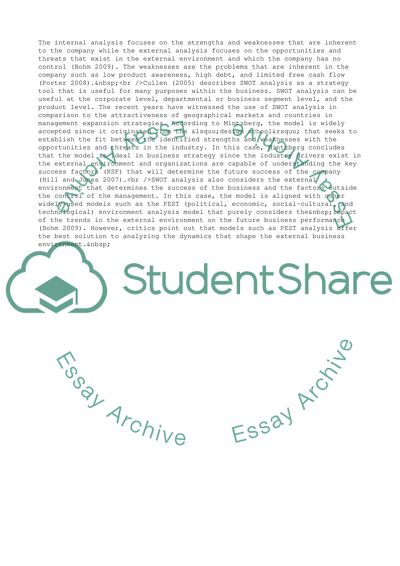Cite this document
(Critical Evaluation of SWOT Analysis Model Case Study Example | Topics and Well Written Essays - 2000 words, n.d.)
Critical Evaluation of SWOT Analysis Model Case Study Example | Topics and Well Written Essays - 2000 words. https://studentshare.org/management/1861931-1the-swot-analysis-became-a-basis-from-which-a-companys-strategy-is-built-however-when-used-it-in-a-wrong-manner-it-can-jeopardize-the-future-of-a-company-using-some-specific-examples-of-your-choice-evaluate-the-swot-model
Critical Evaluation of SWOT Analysis Model Case Study Example | Topics and Well Written Essays - 2000 words. https://studentshare.org/management/1861931-1the-swot-analysis-became-a-basis-from-which-a-companys-strategy-is-built-however-when-used-it-in-a-wrong-manner-it-can-jeopardize-the-future-of-a-company-using-some-specific-examples-of-your-choice-evaluate-the-swot-model
(Critical Evaluation of SWOT Analysis Model Case Study Example | Topics and Well Written Essays - 2000 Words)
Critical Evaluation of SWOT Analysis Model Case Study Example | Topics and Well Written Essays - 2000 Words. https://studentshare.org/management/1861931-1the-swot-analysis-became-a-basis-from-which-a-companys-strategy-is-built-however-when-used-it-in-a-wrong-manner-it-can-jeopardize-the-future-of-a-company-using-some-specific-examples-of-your-choice-evaluate-the-swot-model.
Critical Evaluation of SWOT Analysis Model Case Study Example | Topics and Well Written Essays - 2000 Words. https://studentshare.org/management/1861931-1the-swot-analysis-became-a-basis-from-which-a-companys-strategy-is-built-however-when-used-it-in-a-wrong-manner-it-can-jeopardize-the-future-of-a-company-using-some-specific-examples-of-your-choice-evaluate-the-swot-model.
“Critical Evaluation of SWOT Analysis Model Case Study Example | Topics and Well Written Essays - 2000 Words”. https://studentshare.org/management/1861931-1the-swot-analysis-became-a-basis-from-which-a-companys-strategy-is-built-however-when-used-it-in-a-wrong-manner-it-can-jeopardize-the-future-of-a-company-using-some-specific-examples-of-your-choice-evaluate-the-swot-model.


